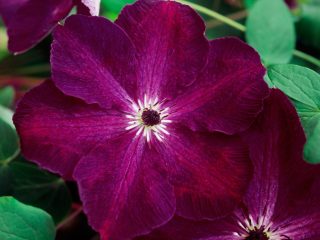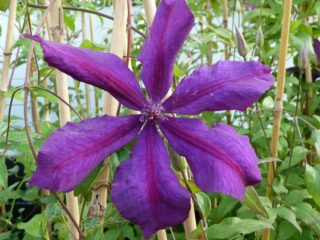Content
The area in front of the house, a small courtyard, and even a balcony with a terrace can be transformed beyond recognition if you decorate them with flowering vines. Clematis will cope best with this task. In this article we will talk about clematis variety Piilu, it will be described, photos and reviews of gardeners growing it in various parts of our country.
Description and characteristics of the variety
Clematis variety Piilu was created by Estonian breeder Uno Kivistik in 1984. After several years of testing, the variety received its current name, which translated from Estonian means “little duckling.”
This variety of clematis is compact, therefore, unlike many of its counterparts, it can be grown not only in the garden, but also on the terrace, and even on the balcony, if planted in a sufficiently spacious container.
Individual shoots grow no more than 1.6-2 meters in length. And, according to reviews from gardeners who grow clematis Piilu in rather harsh climatic conditions, the length of its shoots may not even exceed 90 cm.
The flowers are of medium size, can reach 10-12 cm in diameter. The flowers themselves, or more precisely, the sepals, have a very beautiful pink-purple color. From the base of the petals, a dark pink stripe stands out in their center. And the anthers have a bright yellow color.This combination makes clematis Piilu flowers very attractive to any lover of these wonderful plants.
Each simple flower contains 4-6 petals with a wavy edge, while double flowers can have 3-4 times more petals.
But on the shoots of the current year only simple, non-double single flowers appear.
Bushes of this variety are distinguished by moderate growth and grow upward, clinging to supports with leaf petioles. Flowering usually begins in June, but under favorable conditions, an adult bush that has survived the winter well can bloom very early in the middle or even early May. The flowering is very abundant - the entire bush is completely covered with wide-open flowers. In August - September, clematis Piilu produces a second wave of flowering, already on the shoots of the current year.
Gardeners have many questions about which pruning group Piilu clematis belongs to. Of course, according to the official classification, this clematis belongs to the second pruning group, if only because it can bloom both on the shoots of the previous and current year.
But many gardeners living in areas with harsh winters, trying to grow clematis in their plots, noticed that many of them belong to the transitional group 2-3. That is, there are clearly defined representatives of the 2nd group, mainly Japanese hybrids and double beauties, which are able to bloom early and abundantly only on last year’s shoots. But on young shoots they bloom too late, rather reluctantly, and in unfavorable weather conditions during the summer they may not bloom at all.
The same clematis that belong to the transitional group 2-3 bloom equally profusely and well on both young and last year's shoots. It is to this transitional group that the clematis variety Piilu belongs. The only difference is that, as mentioned earlier, during the second wave of flowering, double flowers do not form on the plant.
Landing Features
The place for planting clematis must be chosen with special care - after all, the main feature of these perennial vines is that they absolutely cannot tolerate spring flooding. True, clematis Piilu is capable of growing even in containers, and in this case, care must be taken to provide a good layer of drainage in the growing container.
If you decide to plant clematis Piilu in the garden, then it is advisable to choose a sunny place for it, protected from drafts, but, most importantly, on a small hill so that there is no stagnation of moisture at the roots.
You can plant clematis in a permanent place both in spring and autumn, but for the middle zone and more northern regions, the spring period is preferable, since it allows the plants to take root well during the warm season. Since clematis Piilu, like many other varieties, can grow in one place for up to 20 years, its planting must be taken very seriously. It is best to dig a planting hole or trench (if you want to plant several plants) with a depth and width of at least 60 cm in advance, about 2 weeks before planting.
Place drainage in the form of small stones or crushed stones at the bottom, in a layer of about 5 cm, then another twice as thick layer of cut branches and various organic waste mixed with sand. Clematis does not tolerate acidic soils, so lime can be added to the same layer.
From above, everything is carefully covered with garden soil with the addition of humus, compost, complex mineral fertilizer and sand - the main thing is that the soil is loose, light, air- and water-permeable. Then the planting site is watered generously and kept moist until planting.
The depth of planting a clematis seedling depends on the region where you are going to grow it. In the northern regions, seedlings should never be buried - it is better to plant them at the same level at which they grew in the container. It is better to annually add humus to the roots and mulch the planting site. But in the southern regions, the clematis seedling Piilu must be deepened into the ground by 8-12 cm.
The distance between clematis seedlings Piilu can be left about 80-100 cm so that they do not interfere with each other when they grow.
Care and pruning
When caring for the Piilu clematis variety, it is important to comply with the following basic requirements:
- Watering should be regular and quite abundant, especially in hot and dry southern regions, where the vine can be watered almost every day. In more northern regions, watering 2-3 times a week will be sufficient.
- For the first year after planting, clematis may have enough fertilizer placed in the hole during planting. But from the second year of life, clematis must be fed regularly, at least 4 times per season. You can use complex mineral fertilizers, such as Crystallon, or you can use any organic matter: humus, compost, humates.
- Clematis Piilu does not tolerate proximity weed. In order not to suffer too much with weeding, every spring it is advisable to mulch well the entire root zone of clematis bushes.
- At some distance from the root zone of clematis, you can plant low annuals that will protect the roots well from heat or excessive dryness.
Pruning clematis Piilu is not as difficult as it might seem. In the autumn, before the onset of the first frost, it is necessary to cut off last year's shoots, on which the most powerful flowering occurred, almost to the ground (leave about 10 cm). Recommendations for pruning young shoots vary in different sources - they can be trimmed, leaving from 80 cm to 150 cm. You yourself will choose the appropriate length for your region through experience. In northern regions with harsh winters, all shoots of clematis Piilu are pruned to 3-4 buds for the winter. Thus, its care in these regions is carried out according to the 3rd pruning group, which can only affect the presence of double flowers.
Reviews from gardeners
Gardeners who grow Piilu clematis on their plots leave extremely positive reviews about this ornamental vine.
Conclusion
The clematis variety Piilu is relatively unpretentious to growing conditions, can show itself in all its glory even in not very experienced hands, and can be used to decorate various corners of the garden and local area.

















Thank you very much! I even wrote everything down in my garden notebook and am already looking forward to spring!